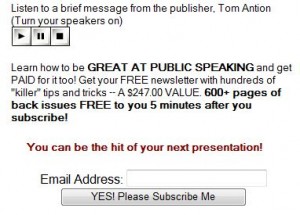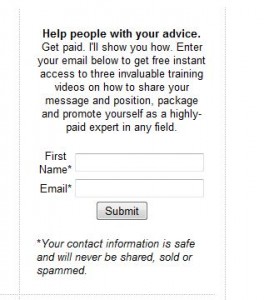When writing for a website or blog some things are the same as writing in a printed document and some things are different.
Category Archives: copywriting
Online Courses In Writing For the Web
Writing copy for websites is a lucrative and in demand skill. Learn how you can discover the hottest and most in demand jobs available today. At the Internet Marketing Training Center of Virginia, you can get a dedicated certificate in as little as six months and be on your way to a great job. Visit the site to download your free career guide.
Certified to operate by the State Council of Higher Education for
Virginia
Useful Blogging Techniques
Blog to Book:
The content of your posts can build up very quickly if you post a couple of times a week. This can all be assembled together to create an informational book. Even guest posts or interviews with other experts can be used to make a book very quickly. It's like hitting two birds with one stone. Not only that, all of your written content can be read by you and recorded as a CD or MP3 product.
Audio blogging is a great way to deliver content to people who want to get their information auditorily. Audioblogging is essentially like podcasting. This is another great way to deliver your content. You can podcast your entire book so it's like an audiobook that you can get at:
Selling audio files creates a loyalty and can attract and different kind of crowd, expanding your customer base.
Flipped the other way, all of your regular podcasts or audio blog posts can be transcribed by someone you can find on Elance.com
Doing interviews for a book, especially for a nonfiction book, is a great idea. Not only can you generate instant content from interviewing famous or semi-famous people, but most people who are in your book are going to get the book and talk about it to their people.
While you're at it you can use a service like: http://www.AudioBlog.com that you can actually call in postings from your cell phone, and they post automatically to your blog, saving you writing time.
Great Copy For The Web: Sub-Headlines
As a person scans down a webpage, he/she quickly scans the subheadings along the way. If the subheadings aren't quickly understandable and enticing, then it is doubtful that the person will decide to go back and read the entire page.
Subheadings can be interspersed throughout the copy to help keep the reader going down the page. There is usually a subheading just beneath the main headline to help add a bit more information to or to re-inforce the main point of the headline. They have a larger font than the rest of the main text, but not as large as the main headline. The font color should be different than the rest of the text above and below it, red or blue works well. A subheading should provide highlights of each section of the sales copy.
Keep your subheadings as short as possible, but still pack a psychological punch. They should be strong enough to almost stand on their own, and compel a scanner to stop and start reading the copy.
A great place to get the subheadings. . . . use all the headlines that didn’t make it as the main headline as subheadings.
Some examples of subheadings:
* How Much Would You Pay For Powerful Training Like This?
* The Times Have Changed and Now It's True!
* Take a Good Look and See Fees That Would Be a Good Month's Salary For Most People!
* Who Would Benefit From This System?
* This System Is a Professional Speaker's Treasurehouse!
Learn how writing great copy can dramatically increase your sales.
How To Write a Strong Online Guarantee
If you are going to bother having a guarantee at all I suggest using strong language to really make it do its work in increasing sales. Don't be wishy washy about it.
The longer the guarantee the better when it comes to reducing the risk to the customer and increasing sales, but your credit card company may have its own restrictions on the length of your guarantee. Many have a six month limit.
Here are a bunch of terms you can use that will put teeth in your guarantee and make people feel comfortable in ordering. Feel free to mix and match:
· Ironclad guarantee
· Unconditional guarantee
· Unconditional money-back guarantee
· Satisfaction guaranteed
· Lifetime guarantee
· 30 day no-risk guarantee
· Try it free for X days and if you're not happy send it back for a complete refund.
· . . . we will promptly refund every nickel you paid
· I'll personally refund your money
· I guarantee that everything you see if truthfully described.
· We stand behind our products with a full money-back guarantee if you aren't satisfied for any reason.
· If this product isn't every bit as wonderful as we say it is, simply return it to us for a full refund.
· No questions asked money-back guarantee
You can put variations of the above phrases into paragraphs like the ones below:
“Everyone says I'm crazy for giving such and awesome guarantee. If you don't think this is the greatest blue widget you've ever seen, return it within 60 days and I'll personally refund every nickel you paid.”
“We believe so much in our red gizmo that we're going to let you try it out for 90 days in your home RISK FREE. If you don't like it send it back and we'll even pay the shipping and give you a no questions asked refund.”
“Our green whatchamacallits are delivered with no risk to you. Everything you see on this page is truthfully described. Use them for six months. If you don't think they are worth three times what you paid, send them back for a full refund.”
Here are some guarantee guidelines:
· State the time period the guarantee is good for and make it as long as possible relative to your offer.
· Use strong language
· Make sure the prospective customer understands that they have no risk.
· Let them know that there will be no hassles if they return the product.
· Tell them the reason why you are offering such a great guarantee.
Start cutting out guarantees from all the print advertisements you get and copy all the ones you see on the web. You'll be able to pick out all kinds of great guarantee language by doing this that you can use in your ad copy.
IMTC shows you the magic of writing good sales copy!
Web Content: A Balance of Important Factors
Writing for the web can be a daunting task. Think about how much content is really out there:
* Website content
* Blogging
* Video and Podcast Scripts
* Articles
* Tweeting, Facebook Updates ans SMS Messaging
* Squeeze Pages, Opt-in Scripts and Sales Letters
That's enough to give anyone a heart attack. Or at least writer's block.
Yes, if you're not a ‘born' writer, it can seem like a lot of work. But you don't have to be a born writer to effectively get your point across to your visitors in all the above elements. It is a lot of work, but most time is spent ‘wondering' what to write, eating up real time you could be typing. Procrastination and doubt are time-killers, and you website can't wait. Getting your writing accomplished can be helped by a template: a quick checklist of factors that you can follow for the most effective content creation. In short order, here are a few to consider:
* Keywords – having a handy list of the keywords that apply to your business not only keeps your content search engine friendly, it gives you ideas for topics.
* Benefits – what are the immediate and long-term benefits of your product or service to your audience? Now explain that to generate good content (lose weight, make more money, save on their taxes, etc…).
* Fun – what enjoyable things will your audience be able to do with your product or service (spend more time with kids, catch bigger fish, look more attractive, etc…).
* Find your voice – write like you talk. Don't make everything sound like a Harvard dissertation. Be yourself so people trust you and get to know the real you. Writing in your own voice gets rid of the ‘fear' of not knowing what to write: it keeps you from over thinking it so you can get to the point and get the content down on paper (or web).
At IMTC, we have easy to follow steps for content creation to get you on and keep you on the right track. Check us out…
Free Content Helps Eliminate “List Exhaustion”
Do you ever get so many sales pitches from one or two companies in your email inbox that you can't stand to open them anymore? Maybe that last “open” you did was to un-subscribe? That happens a lot lately with the email strategies businesses are trying to use. They have a hard time knowing exactly what the best kind of reaching out they should be doing. Most people who use their database list for email marketing fall into one of two categories: those who send out too many emails (list exhaustion), and those who are scared to send out enough (neglected list). The way to get around this hump is free content.
For those marketers who send out too much email, it's important to find the rhythm of your list. How often do they really want to hear from you? You can go as far as to poll them to make sure you're not killing them with mail. A heavy amount of unsubscribes could also be an indicator. With free content however, a solid core of readers will love to hear from you if you are offering real solutions to real problems. Content builds trust and rapport, and will keep your brand at the ‘top of their mind.' The best email is one that has value. It's your job to figure out what is most valuable to your readers and how often they want to receive it. With those two problems solved, you're well on your way to successful email marketing campaigns.
For those marketers who don't send out enough email, free content can help you feel at ease. If you're nervous about ‘offending' or burning out your list, solving their issues with your message can build you into a solid, trustworthy brand. Everyone loves free stuff – they will open the email as long as it has value. Again, finding the right rhythm regarding how often to send email out is the key to a happy list.
Now about pitching. Obviously, after a number of emails have been opened that offer ideal and free solutions, your list will be receptive to offers of helping them further with their problems. Most free content can be disguised as ‘eye openers' or offering real solutions to problems that the readers didn't even know they had. Let your list figure out what's important to them, and they be receptive to products, training or advice to help fix it. A pitchy call-to-action is not necessary. A link to an important resource (your product) is all that's needed. Trust your prospects that they'll do the right thing, and more often or not, they will.
Writing Business Sales Letters: Are You Focusing on Your Company Instead of Your Prospects?
Most business sales letters, promo pages and lead generation pages love to focus on one main item: themselves. It stands to reason that a website promoting a business should talk about themselves as often as possible: how great they are, how easy their products are to use, how often they ‘beat' the competition and other self-aggrandizing features. However, it is becoming clearer to online advertisers and copywriters that concentrating on the visitors themselves has a wider range of interest. Anything that sounds too ‘pitchy' can easily raise walls of objection in the visitor, even if it is crafted to sound like useful features. Remember, it's all about them.
What resonates with most readers is what can benefit them right now. On the Internet, most people are searching for information as opposed to radio and television, where commercials are a break in entertainment. The Internet above most other media, is a vehicle for making decisions: where to find the best deals, how to locate the nearest dentist, how to save money on their taxes and other information. This ultimately means that the end result needs to look more like ‘immediately usable benefits and answers' rather than sales pitches. Good website copywriting can include both the elements of benefits and subtle pitch.
One thing that stands out to visitors subconsciously is the overuse of the words “We” and “Our” in the copy. While it is a very small error by most copywriters, it has a negative effect on the reader. It has a sense of ‘inward' marketing, trying to draw the reader into the copy, rather than an ‘outward' or inclusive feel to the reader. Reaching out to your prospect and touching the points of why they ended up on your website in the first place (concerns, understanding, problem solving, empathy) can make them drop their defenses and open up to receive a subtle pitch.
Good copy has a 2 to 1 ratio of customer focus to company focused jargon. At IMTC, we teach you how to write better copy. This can make you very valuable to big business because you will understand what elements drive online sales more effectively than their in-house marketing people (who love to focus on company ‘benefits'), or any outsourced people could ever dream of being. And you can probably work from home as well. Check us out…
How To Write a Compelling Opt-in Form
Collecting emails for your database is getting harder and more competitive each year. As people receive more and more junk email to their inbox, they are becoming reluctant to sign up for things like they used to, and becoming more selective about what they think is really necessary information. In that regard, the information you are giving away has everything to do with getting that critical conversion. Critical, because building your email list is still the number one most important thing you can do for your business and making money online. These people are your fans: the ones that know you best and you have invested the time to brand yourself to. Your list is more receptive to making purchases than just random traffic. Getting people to sign up has everything to do with how you craft your message in your opt-in form and sign up areas.
Let's look at a couple of really captivating opt-in forms and why they're different from run of the mill stuff:
The above image is an example from Antion.com, the founder of IMTC. A couple of elements stand out:
* The ability to ‘listen to a message' helps make a personal connection.
* Lots of benefits: ‘600 pages of content' means more than just an excerpt or ‘special report'.
* Concentrate on value: “$247.00” and “get paid for it” speaks to the customer about saving and earning money in their industry.
The next example is from BrendonBurchard.com, a very successful info product marketer. The strength of this opt-in is that he is giving away training videos – far more dynamic and easy to understand than text based products. The videos are long, detailed and are made expressly to brand himself as the expert. They are made to funnel the customer towards additional training for purchase. The copy of the opt-in form is simple, concentrating on ‘helping', ‘getting paid' and ‘instant access.' These three elements speak about value in easy-to-understand language, without a bunch of hype.
This is my personal favorite. The above example is from Stompernet.com. They're giving away content so cool, they won't even tell you what's in it. It's disguised as a ‘contest', but it is simply an email gathering device. The promise of a $97 “gift” every week is almost to good to pass up. The visitor will at least sign up to see what the first free gift will be, so it better be good. If the information is sound, full of real world benefits and helps build your brand, you could have a home-run with this strategy.
These are not hard examples to emulate for your own business. They didn't take any more time to put together than the opt-in form on your own website. They may be just a tad more creative, however, helping make that hard-to-get conversion easier for you. Stop with the ‘special reports' and ‘newsletters' and think of something more creative. Make sure that what you are giving away helps make more money for you after the customer gets the email. What are some other techniques that can build a powerful database of customers?
Spreading Your Content – Finding Guest Blogging Partners
Blogging is a very popular way to spread your information. With the competition for blogging traffic so high right now, beginner bloggers will have to work hard to get readers. You can help drive interested parties to your fresh content by writing content for other people's blogs. Some blogs in your niche have been around for years, getting tons of readers and subscribers. Writing fresh content for these blogs puts your expertise in front of the eyes of thousands of people and you get the links to your site. How can you identify blogs that may help publish your work?
Google Alerts is another great way to identify blogs where a certain topic is being discussed. After selecting a keyword phrase for your alert (and you can multiple alerts), Google will email you links everyday to blogs mentioning that phrase or topic. Now you know who to contact for a guest spot. Often, conducting a simple Google search for “Top 100 blogs on leadership skills” or whatever your topic happens to be, can help identify not only blogs relating to yours, but ones that are popular or have a high page rank. You want to write for blogs that have high traffic and a high page rank. Use http://www.checkpagerank.net/ to see how popular a blog might be before wasting your time contacting the blog owner. Having a popular blog link to yours will help with your linking strategy: one of the most important parts of getting good search engine positioning. We explain all the aspects of this article: blogging, writing, linking, SEO and social media at the Internet Marketing Training Center. Check out how you can use these techniques to effectively create a money-making blog or help someone else to make theirs profitable.










